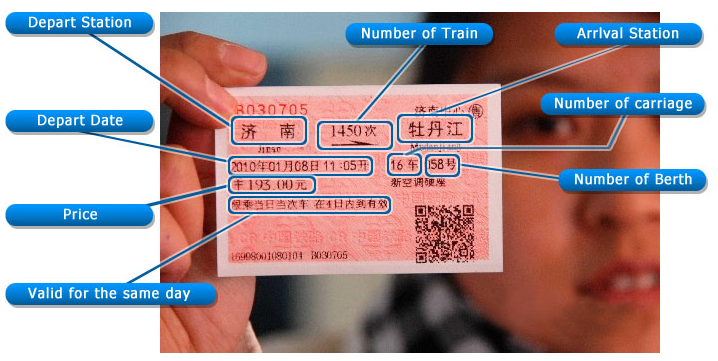Domestic Trains
-
How do I read a train timetable?
Trains in China usually have a letter followed by a number e.g. Z 19. Times are shown in the 24-hour clock e.g. 1700-0800 ¨C in this case 0800 is 8am the following day. This is usually shown as 0800+1.
-
What is train travel like in China?
Train travel is an interesting, inexpensive and safe way of getting around China. It offers you more chances to get to know Chinese people.
In China, the accommodations on the train are divided into four categories: soft-sleeper, soft-seat, hard-sleeper and hard-seat. Usually the soft sleeper carriage is air-conditioned, which is what we suggest you take.
Please be aware that each carriage has only two washrooms, one at one end of the carriage, but without shower or tub; meals and drinks can be purchased in the dining car, but they are comparatively expensive and not very good; no English-speaking conductors are available on the train; and during national holidays, spring festivals, and student's vacations, there are many, many people at the train station and on the train.
We suggest you book train tickets through travel agencies early to guarantee the soft sleeper tickets.
-
Are there bathroom and/or toilet facilities on the train?
Inside China, it is very hard to find a bathroom with a shower on the train. Western style washrooms and toilets are located at both ends of each carriage.
-
Can you explain all the information included on a China train ticket?

-
How much luggage can I carry when boarding the train?
The China Ministry of Railways stipulates that the weight of small luggage that you may carry with you on the train is limited to 20 kilograms (44 pounds). Large baggage exceeding the limit can be checked into the train and the related formalities will need to be transacted at the railway station before your departure.
-
In the soft sleeping carriage, are there private compartments for two?
No. We usually do not arrange private compartments for two people if not required. In China, most of the soft-sleeper carriages are divided into separate compartments with four berths - two lower and two upper - and we usually arrange one ticket for each client. Compartments for two are only available on some trains on some routes such as from Beijing to Shanghai, Xian, Wuchang and a few other cities.
-
How far in advance should I book a domestic (within China) train ticket?
It's the China Railway policy to issue the tickets 5-10days before departure, so you need to book the tickets at least 10 days in advance. For Chinese festivals such as May Day (May 1st, 3 day holiday), National Day (Oct 1st, 1 week holiday) and Chinese New Year, train ticket demand is extremely high. If you plan on travelling during these times, you should make the reservation as early as possible.
-
What are the different travel options on the trains?
Chinese trains generally have 4 classes, although you won't find every class on every train. Generally speaking, soft sleeper is the best; the following is respectively hard sleeper, soft seat, and hard seat.
Soft sleeper: Soft sleepers are spacious 4-berth compartments with two upper & two lower berths by night, converting to two sofas for daytime use, which is normally called luxury train class.
Hard sleeper: Hard sleeper consists of open-plan carriages with a broad aisle on one side of the car, bays of 6 bunks (upper, middle & lower) on the other side.
Soft seat & hard seat: Short distance daytime trains often only have hard class seats, though some inter-city trains have both soft & hard class.
-
What are the different types of trains in China?
Chinese train numbers usually start with a letter, which indicates the category of train. The better the category of train, the faster it is likely to be, and the more modern & comfortable the carriages are likely to be. Slightly higher fares are charged for the better train categories.
C, D & G trains (modern high-speed daytime & sleeper trains): These are top-quality high-speed trains with ultra-modern air-conditioned coaches and streamlined power-cars at each end. Some are 200-300km/h daytime electric trains, a few D-trains are top-quality 200km/h sleeper trains.
Z trains (high-quality express sleeper trains): The previous top-quality sleeper train, the 'Z' trains are now the second best, but still with very modern air-conditioned coaches.
T trains ('extra fast'): Trains with a 'T' in the train number are the next best category, see the photos below.
K trains ('fast'): Trains with a 'K' in the train number are 'fast'. Slightly higher fares are charged for better categories of train.
A typical T or K category Chinese train...'T' & 'K' category trains may not be as glamorous as the front-rank 'D' or 'Z' category trains, but even these T or K trains are usually very comfortable, often modern & air-conditioned.
-
How about the restaurant cars, toilets, smoking on the train?
Toilets: Chinese trains generally have both western & 'squat' toilets, but it's always a good idea to take your own supply of toilet paper. The toilets on the modern D & Z category trains are immaculate, so no worries there!
Restaurant cars: Most long-distance trains have a restaurant car, with waiter service of drinks, snacks & meals. The best trains on key routes such as Beijing-Shanghai have menus in both Chinese and English.
Smoking: Smoking is not permitted in the sleeping-car compartments or corridors on Chinese trains, but is allowed in the vestibules between carriages and in the restaurant cars.
